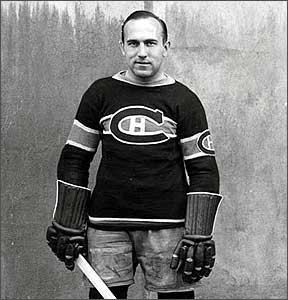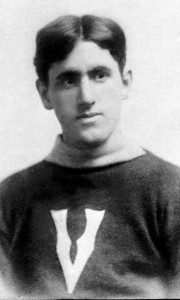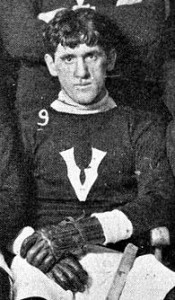Before the days of Wayne Gretzky shattering every scoring record in the NHL books, there was Gordie Howe, who, on the day of retirement, was the highest scoring player in NHL history by 383 points over Stan Mikita. Before Gordie Howe’s career was finished, there was Maurice Richard, who retired with 544 goals, 98 more than Gordie Howe at the time in 1960. Before Maurice Richard, there was Howie Morenz, regarded by many as the first real superstar in the history of the NHL. On the day of Morenz’s untimely death in 1937 while still an active player, no player had more than Morenz’s 472 career points.

And that’s where 99.9% of a fan’s knowledge of the history of the game ends. After all, the NHL started in 1917, and Morenz’s NHL career started in 1923. That means Morenz was hockey’s first superstar, right?
Wrong.
While the NHL as we know it was not created until 1917, organized hockey was being played at an organized, high level prior to that. The classification of it wavered between amateur and professional (more on that later), and between a variety of leagues.
There are many players that are enshrined in the Hockey Hall of Fame from this little-known era, but there is one that stands above the rest as the first true superstar of hockey. His name was Russell Bowie.
Russell Bowie By the Numbers
Russell Bowie played in an era where hockey as we know it was different. There was a 7th player, a Rover, on the ice who played essentially as a mid-fielder. Forward passes were only allowed in the defensive and neutral zones. Assists were not tracked, so goals are the measure that should be used to measure offensive prowess.
Bowie was a staunch amateur who refused to accept a cent as compensation for playing, despite repeated offers from teams. But make no mistake, the title of “amateur” does not diminish his accomplishments.
Bowie played parts of ten seasons in what were considered the top leagues at the time, the CAHL and ECAHA. These leagues (in the eastern portion of Canada) would then face off against a team from a league in western Canada in the early editions of the Stanley Cup.

In these ten seasons, Bowie led his league in goals five times, was second four times, and third once. To finish in the top three in goals in every season in which you played is an unreal accomplishment in and of itself. But when you dig even deeper into the numbers, you get a sense of the magnitude in which Bowie dominated every other player during the era.
In these ten seasons, from 1899 to 1908, Bowie scored 239 goals in 80 games for a GPG average of 2.99. The next closest player was Blair Russel (a Hall of Famer himself), who scored 109 goals in 67 games for a GPG average of 1.62. For those that are mathematically challenged, that’s 119% more than the second place scorer on a raw basis and 84% more on a per-game basis.
For a reference, between 1979-80 and 1988-89 (Wayne Gretzky‘s most dominant 10 year stretch), Gretzky scored 84% more (1,837 points) than the second place scorer Peter Stastny (986 points), and 62% more on a per-game basis.
In the five seasons in which Bowie led the league in goals, he led the second place scorer by a combined 41 goals. In two of these seasons, Bowie was the only member of his team (the Montreal Victorias) in the top 10 in the league in goals. The Victorias were far from the most talented team in the league.
Russell Bowie By the Anecdotes
The numbers aren’t the only thing to suggest that Bowie was hockey’s first real superstar. Newspaper articles and books from the day describe his dazzling style and abilities on the ice.
From the Montreal Gazette on February 15th, 1905:
Bowie does not win games with his skates. His head and hands have brought him the reputation he holds as the most effective scoring player in the game…Bowie, in the minds of the rooted who have followed the game for year, is the trickiest hockey player that ever stepped on the ice.
From the Calgary Daily Herald on January 15th, 1912:
I see Russell Bowie is up to his old tricks of making the goal-keeper look like a wooden Indian in front of a cigar store. There was one great player who could have filled in his own figures to the N.H.A. contract if he wanted to participate in the pro league. To my mind he was the greatest player that ever lived. He was fast and brainy. His stick was a magnet to the puck and he walked right in on the defence before he ever thought of shooting.
From Turning Back Hockey’s Pages on April 5th, 1934:
The slight, almost frail rover of the Victorias played during what was probably the roughest era of hockey for he was a starred member of Victorias when the Silver Seven was in its heyday. It took more than ability to score goals to get by against such stalwarts as McGee, Pulford and the Smiths but even in this company, Bowie, over a period of ten years, was the leading scorer in the Eastern Canada Hockey Association. Bowie was probably the shiftiest player that ever carried a puck. He could nurse the disc between his skates and swing through the opposition, avoiding checks, with a deftness that beggars description. He was probably also one of the smartest players who ever handled a stick. And, though he was a marked man in every game he played, he led the E.C.H.A in scoring in practically every season from 1900 to 1909. When the National Hockey Association was formed, the amateur Vics dropped from competition and Bowie never played again except in exhibition matches.
Despite being a smaller player in a rough and tumble era, playing with an inferior supporting cast, Bowie was able to put up these dizzying numbers.
Bowie in the Modern Era

Certainly, you are wondering what Russell Bowie would have done in today’s modern NHL, or even the Original Six era. The comparison is difficult because the game of today is so different than the version Bowie played. It would be irresponsible to say Bowie was just as good as Gretzky because of the numbers mentioned above. However, it would be just as irresponsible to say Bowie wouldn’t hack it in today’s NHL because the speed and skill at the time he played was nothing compared to today’s modern game.
If you gave Bowie the advantage of modern equipment, training, and compensation, I have no doubt that he would be widely regarded as a star. But he didn’t play in anything close to the modern era, so we cannot say for sure.
Hockey historian Iain Fyffe has attempted to quantify how impressive Bowie’s exploits are, and the results are interesting. He concludes that two of Bowie’s seasons, 1901 and 1903, were at a Wayne Gretzky/Bobby Orr level of dominance.
In 1901, Bowie led the league in goals with 24 (second place had 10). His 24 goals were more than the entire Quebec franchise scored that season (21). In 1903, he led the league in goals with 22 (second place had 14), and outscored the Montreal Shamrocks franchise (21 goals).
Bowie’s career effectively ended in 1908 when the ECAHA was disbanded, and the professional NHA (which evolved into the NHL) was formed. He was voted into the Hockey Hall of Fame in 1947.
This article was originally written in March, 2016.